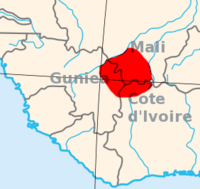- Wassoulou
-
Wassoulou (var. Wassulu, Wassalou, Ouassalou) is an historic region in southwest Mali, northeast Guinea (Prefectures of Kankan, Kerouané, Beyla, and Siguiri) and the area west of the Sankarani river and south of the Niger River in Mali and Côte d'Ivoire. Centered around the town of Yanfolila, (in the Cercle of Yanfolila, and the Sikasso Region, 150 km south of Bamako), historic Wassoulou has an estimated population of 160,000. Other towns in Wassoulou include Madina Diassa and Bougouni. The region is named for the Wassoulou river valley.
Wassoulou is not the name of any formal governmental entity in any of the three modern nations into which it falls, but rather an historic, cultural region. It should not be confused with the formal Regions of Mali, the Regions of Côte d'Ivoire, or the Regions of Guinea.
Contents
Culture
Wassoulou is best known internationally as the birthplace of Wassoulou music, a style which blends traditional and modern influences with strong female vocalists and a pentatonic hunter's harp. Wassoulou music is one of the two forms of West African music ethnomusicologists believe to be the origin of the American blues, which developed out of music forms dating back to the American slave trade from West Africa. Some of the most famous residents of Wassoulou include the singers Oumou Sangare, Ramata Diakite and Coumba Sidibe.
Wassoulou's cultural importance is reflected in the development of internet resources, and the creation of Radio Wassoulou broadcasting from Yanfolila.
Language
Wassoulou is also a dialect of the Eastern Maninkakan language, and is closely related to Kankan Mandinka. Speakers of Wassoulou number some 73,500 in Guinea, with 41,200 speakers estimated in Mali, where the closely related Bamanankan is also spoken. In the far northwest of Côte d'Ivoire there are some 21,000 Wassoulou speakers, where it is related to Wojenaka Maninka.
Inhabitants are known as Wassulu, Wassulunka or Wassulunke.
History
The Wassoulou area is a center for the mingling of several ethnic groups. The nomadic Fula people, who were believed to have emigrated from the Fouta Djallon highlands to the west, integrated into the indigenous Mandé people and adopting their language and customs sometime prior to the 18th century, at roughly the same time Islam spread into the area. There are also large populations of Bambara peoples native to Wassoulou.
Wassoulou is also the name of an Islamic state, the Wassoulou Empire (1870-1898), ruled by Samori Ture and centered around his capital, Bissandugu. Samori overthrew the older Wassoulou state of Fama Dyanabufarina Modi in 1870, and expanded his empire from there, taking the Wassoulou name. While the history of the Mandinka Wassoulou states remain unclear, the small kingdoms of Kenedugu and Wassulu existed from at least the 1650s CE, benefiting from gold mining and trade in the area.
See also
References
- Mandinka and Bamanankan in Gordon, Raymond G., Jr. (ed.), 2005. Ethnologue: Languages of the World, Fifteenth edition. Dallas, Tex.: SIL International. Online version: http://www.ethnologue.com/.
- Échange école Joliot Curie, école Wassoulou, Février 2007, Joint French - Malian Education Project (EDDUFAO), in the villages of Guéna, Djélibany and Kaka.
- Portrait of the most famous Female Griot from Wassoulou: Oumou Sangaré, Abidjan.net.
- calabashmusic.com's guide to Wassoulou Music.
- Radio Wassoulou.
- Geekcorps Mali » First digitally-created broadcast from Radio Wassoulou - Yanfolila. October, 2004.
- Launch of the internet connection in Yanfolila USAID, 29 January 2005.
- Le Président de la République du Mali: Visit to Wassoulou, 2006
- PLAN DE SECURITE ALIMENTAIRE COMMUNE RURALE DE WASSOULOU BALLE, 2006-2010. Projet de Mobilisation des Initiatives en matière de Sécurité Alimentaire au Mali (PROMISAM), 2006.
- Etude diagnostique pour le Marketing Social de l’Hygiène et de l’Assainissement dans les villes de Bougouni et de Yanfolila, Helvetas Mali - ASP-EAU, December 2004. (Includes detailed descriptions and basic statistics for two towns in the region).
Categories:- Geography of Mali
- Malian society
- Geography of Guinea
- Guinean society
- Geography of Côte d'Ivoire
- Ivorian society
- French West Africa
Wikimedia Foundation. 2010.

